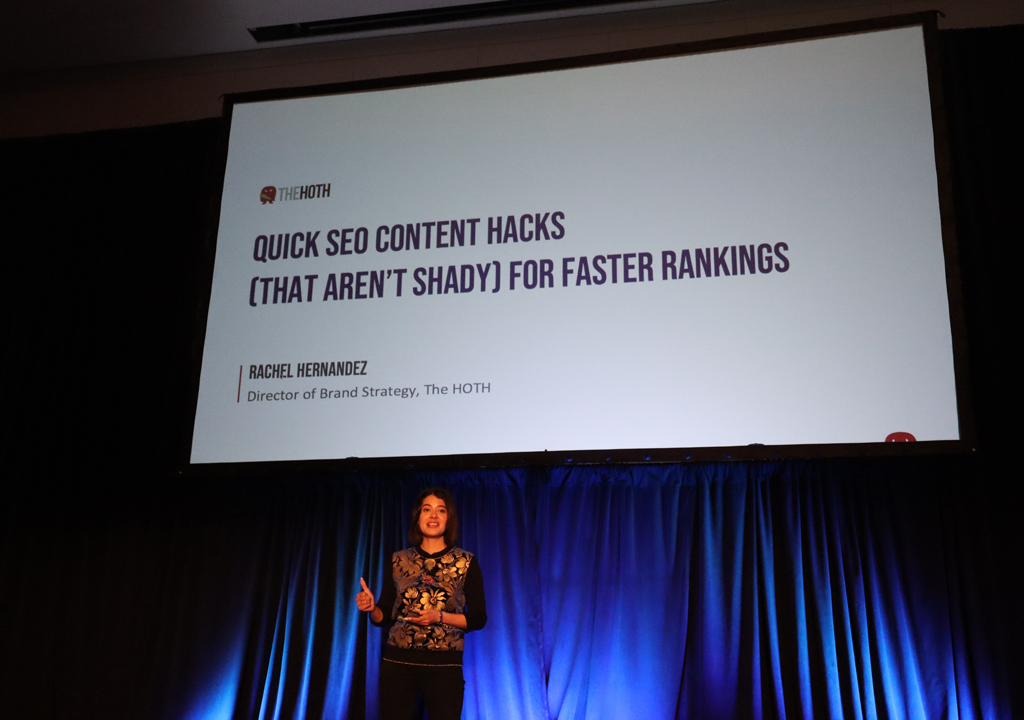
In this article, I’ll go over some ways that you can use quick wins to improve your SEO. These tasks are things you can do relatively quickly to get better search engine rankings. Rachel Hernandez from The HOTH presented these tips at a conference I recently attended. If you’re not familiar with The HOTH, they’re an SEO and PPC services company that offers help with link building, content creation, PPC ads, video production, content syndication, and more. I’ve used the many times in the past to help improve my SEO. I’ll leave a link at the end of this article if you want to check out more of their services.
Here, I’ll go over the main concepts that Rachel presented along with my own takes and experiences on how implementing these strategies has helped me out with my websites.
Blogging is Still a Cornerstone Strategy
Contrary to what you might think, blogging is still the best way for many website owners to improve their SEO and increase their conversion rates. When you have an active blog, you get more search indexed web pages, more website visitors, and more backlinks! Also, remember that people go to Google both for information on products and when they’re ready to make a purchase.
Key Blogging Strategies
In her presentation, Rachel Hernandez recommended that you generate 16 or more blog posts per month to move the needle for your site. Updated pieces of content also count toward your monthly post count. For example, creating 12 new blog posts and updating 4 old ones to include new and update content would get you to your 16 post per month goal. Rachel also stated that your blog post should be 2000 or more words in length to get ranked.
While I believe these are great guidelines to start with, I do think there are a lot of variables with the search algorithms, so I wouldn’t say that any number is set in stone for everybody. Personally, I’ve always felt that consistent blogging or content output is the key. Certainly, the more content you create, the better chances you have at getting ranked. Again however, I believe the important point is to continually generate helpful content on a consistent basis (whether that’s every day, two or three times a week, or weekly).
As for content length, again while generally the more information and data you can include in a blog post, the better chance you have to rank in Google, I would use 2000 words as an approximate guide. I have blog posts that are only 500 to 1000 words long that rank at the top of Google. It really depends on your niche, the competition, and what keywords you’re targeting. I do agree that if you’re trying to rank for a very popular keyword, then you want to create a longer blog post—at least 2000 words in length.
Keep Search Intent in Mind When Creating Content
Now that we have some guidelines to start creating your blog content, I want to point out here (as Rachel did in her presentation) that you need to keep in mind your audience’s search intent when planning and generating your content. The majority of search intent is for informational and navigational purposes. There are non-transactional pages that contain information on topics related to products or services that people search on Google for.
A smaller percentage of search intent is for research and discovery. Here, the user obtains more detailed information on what they’ve learned from your informational pages. These pages are where you can include a call to action.
And finally, at the smallest (but most important) percentage of search intent is purchasing. Here is where your audience is ready to make a purchase and complete a conversion. While it’s obviously important to create content for purchase intent, don’t make the mistake of only focusing on this phase. For better SEO, you really need to focus equally on your informational and research pages of content.
How to Find Topics that Rank Quickly
So, how can you find topics to write about that you can rank quickly with? If you’ve read some of my other articles on my site, you know that Google and its algorithm are all about authority and trust these days. In her presentation at Digital Summit, Rachel showed how you can use a tool such as SEMrush or Ahrefs to check the pages on your website and find out which ones are ranking for the most number of keywords. That’s where you’re already seen as an authority by Google, so you should start creating content on those subjects.
You can also use online tools such as SEMrush to check your competition to find out what posts of theirs are ranking for the most keywords. Then, you can go ahead and create your own blog posts targeting those keywords.
I leave links to my favorite online SEO tools at the end of this article.
Don’t Forget about YouTube
Video continues to be very important, but not necessarily as a money-maker or conversion vehicle. The value of creating helpful videos on a consistent basis is that you can generate more traffic and backlinks—and rank for more keywords (both in Google and in YouTube search).
Although videos can sometimes take time to create, there are ways to outsource tasks to speed things up. Again, I’ll leave some links for outsourcing at the end of this article.
Tips for Refreshing Your Content
Earlier, I mentioned that refreshing your content can also count toward your monthly blog post count. What are the best ways to refresh your blog posts? Rachel recommended checking your word counts to make sure you have enough content in your old posts. You can also add or update videos and photos. You should also add the appropriate header tags (H2, H3, etc.) if they are currently missing. And, update your internal and external links.
One technique that has worked well for me in the past is to combine smaller posts that I’ve previously created into one larger blog post. By creating this new piece of content consisting of old posts together with updated information, I’ve gotten great search engine results.
One more tip that Rachel gave that I’ve also used with success is to republish your updated post with the current date. That way, it gets re-crawled and hopefully gets you better rankings.
Use These SEO Tools for More Help
To Research Keywords and Your Competition:
To Improve Your YouTube SEO:
For Backlinks and Content Creation:

